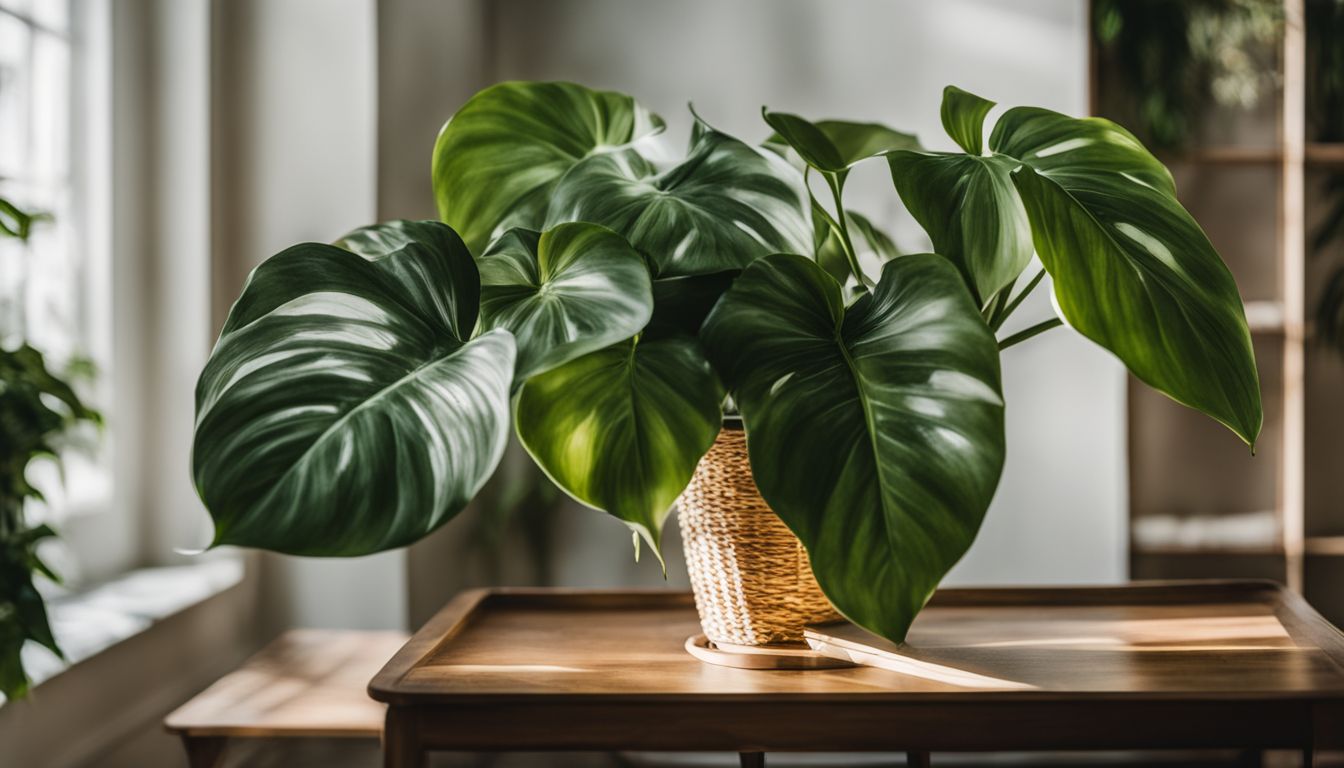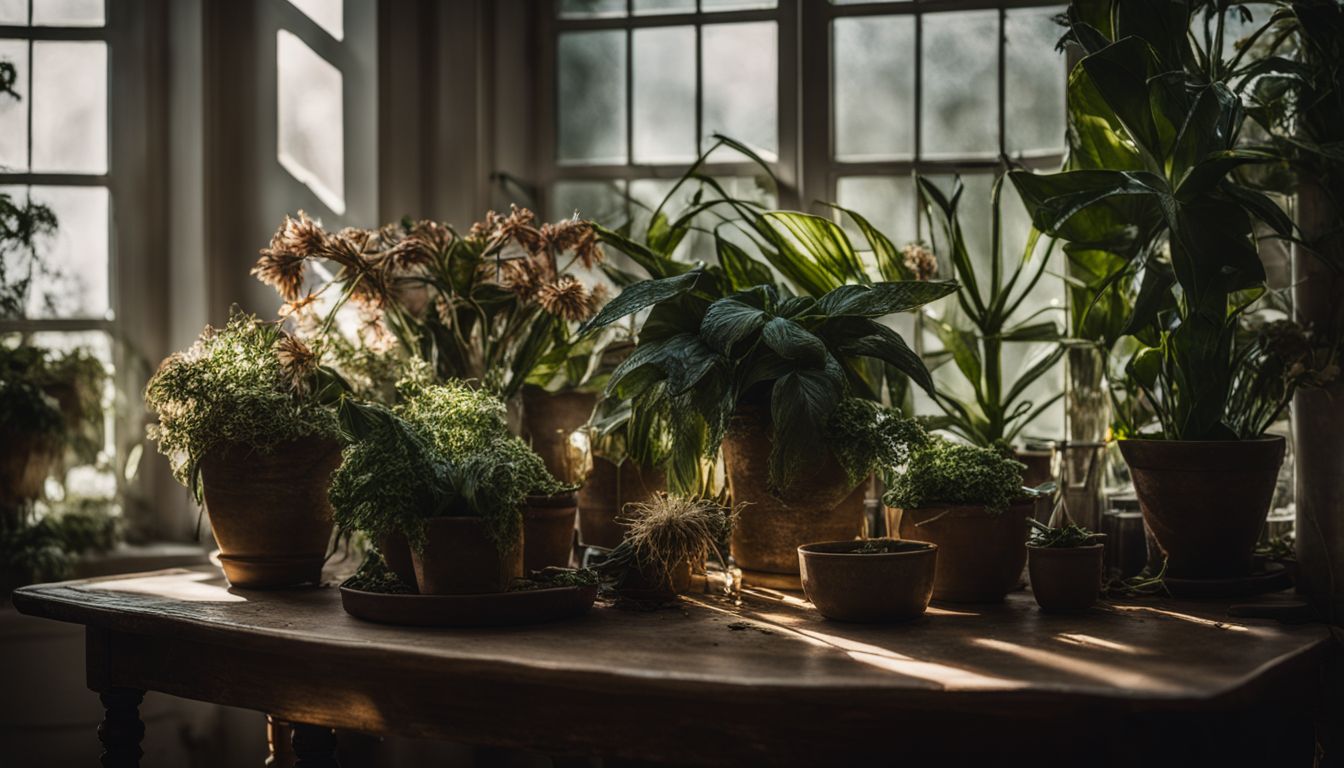I want to talk about Philodendron Birkin Yellow Leaves plant might turn yellow and how you can make them green again. If you see your plant’s leaves turning yellow, it means something is not right.
Too much water can hurt its roots and make the leaves yellow; this is called root rot. Not enough water does this too, but the leaves will look dry and curl up first. Too much or too little light also makes the leaves sad and yellow.
Sometimes plants don’t get the food they need from soil, which are things like nitrogen, iron, or magnesium, so their leaves change color because they’re hungry. Older plants might show their age with a few yellow leaves that droop down.
Also, if your Philodendron Birkin feels stressed out from overwatering or other problems, it may stop showing its pretty white patterns on its green leaves.
To keep your plant happy and looking great with lots of green leaves, give it just enough water by checking how wet the soil is before watering again. Make sure it gets bright but not direct sunlight all day long – think of a spot that’s cozy but not too bright or dark for reading a book! Feed your plant sometimes to ensure it has all nutrients needed for staying healthy.
Taking good care of my Philodendron Birkin means being careful about these things daily so my leafy friend stays strong and beautiful.
Ready to learn more? Let’s help those yellowed friends turn back into lush greens together!
Key Takeaways
- Yellow leaves on a Philodendron Birkin can come from too much or too little water, bright light, and not enough food. Check the roots for rot if it’s overwatered and give more water if the soil is dry.
- It needs indirect sunlight to avoid leaf burn but make sure it’s not too dark either. Rotate your plant so every side gets light.
- Give your Philodendron Birkin plant food with the right mix of nutrients regularly, especially during its growing season. Use things like balanced fertilizer or iron spray if needed.
- New green leaves replacing older yellow ones is normal as your plant grows. But changes in care might cause variegated leaves to turn solid green, so try to keep things stable for your plant.
- Look at your Philodendron often; remove dead leaves and check for bugs that can harm it. Keep records of how you take care of it to help spot any problems and fix them fast.
Understanding Philodendron Birkin Yellow Leaves

The Philodendron Birkin is known for its striking variegated leaves, but yellowing can occur due to various reasons. It’s important to recognize the signs and symptoms of yellowing leaves in order to address any underlying issues and maintain the plant’s health.
Signs and Symptoms of Yellowing
Yellowing leaves on a Philodendron Birkin can catch your eye and signal that something’s not right. One way you might spot trouble is by seeing the vibrant green leaves turn pale or develop yellow spots.
Sometimes the edges of the leaves go yellow first, or you might see a single leaf turning fully yellow while others stay green.
Brown patches mixed in with the yellow are bad news too – they often mean overwatering. If I notice my Philodendron’s leaves drooping and turning yellow at the same time, it’s usually a sign that I’ve been giving it too much water.
On days when I check my plant, dry soil can also be why some leaves look sad and start to fade because every plant needs just enough water to thrive.
Common Causes of Yellow Leaves

Overwatering and root rot, underwatering and dry soil, excessive light exposure, nutrient deficiencies, natural aging of the plant, and reversion of Philodendron Birkin leaves can all lead to yellow leaves.
Read more to learn about how to address these issues.
Overwatering and Root Rot
I know how much you love your Philodendron Birkin, but sometimes its leaves turn yellow. This can happen if the plant gets too much water. Giving it more water than it needs makes the soil too wet for a long time.
Wet soil can hurt the roots and make them rot.
If I see my plant’s leaves drooping and turning yellow, I look at the roots right away. Root rot looks like dark, mushy roots instead of healthy light-colored ones. To avoid this problem, I check that my potting mix drains well and never let water sit in the saucer under the pot.
Keeping a good watering schedule helps me give just enough water without going overboard.
Underwatering and Dry Soil
Your Philodendron Birkin might be thirsty if its leaves start turning yellow. When you don’t give your plant enough water, it can’t make chlorophyll well, which is what keeps its leaves green.
You may notice the edges of the leaves curling inward as a cry for help because the soil is too parched.
Be kind to your plants and check their soil regularly. If it feels dry a couple of inches down, it’s time to water your Philodendron Birkin. Just remember not to wait until older leaves turn yellow without any signs of browning—that’s another hint that your plant needs more water.
Next up, let’s discuss how too much light could also be making those leaves lose their color.
Excessive Light Exposure
To avoid yellow leaves on your Philodendron Birkin, it’s crucial to consider the impact of light exposure. Excessive light can lead to leaf discoloration and sunburn. This specifically affects the variegated leaves, causing them to turn brown or develop dry patches.
It’s important to strike a balance by providing bright, indirect light for your plant without subjecting it to harsh, direct sunlight for extended periods.
Ensuring optimal conditions is key – consider adjusting the distance between your Philodendron Birkin and the source of light if you notice signs of excessive exposure. Remember that these plants thrive in medium to bright indirect light; consequently, taking measures such as moving them further away from windows or using sheer curtains can help manage their light intake effectively.
Nutrient Deficiencies
Nutrient deficiencies in Philodendron Birkin plants can cause their leaves to turn yellow. Lack of essential minerals, such as iron or magnesium, may lead to this issue. When the plant doesn’t get enough nutrients, its leaves struggle and start showing signs of distress.
It’s crucial to ensure that your Philodendron Birkin receives proper nutrition to maintain its vibrant green color and overall health.
To address nutrient deficiencies, consider using a balanced houseplant fertilizer specifically designed for aroids like the Philodendron Birkin. These fertilizers provide essential minerals that support healthy growth and vibrant variegation development.
By incorporating an appropriate fertilizer regimen into your plant care routine, you can help prevent yellowing leaves due to nutrient deficiencies while promoting the optimal health of your beloved Philodendron Birkin plant.
Natural Aging of the Plant
As a birkin philodendron matures, it’s natural for older leaves to turn yellow and eventually drop off. This is a part of the plant’s growth cycle, making space for new leaves to unfurl.
As the plant ages, its energy shifts towards producing new foliage and away from sustaining older leaves. Therefore, seeing some yellowing on the lower or inner leaves is normal as long as the rest of the plant looks healthy.
Remember that addressing common care factors like light exposure and watering can help manage stress on your plant during this phase.
Reversion of Philodendron Birkin Leaves
Philodendron Birkin leaves may revert due to inconsistent variegation, especially if the plant is stressed. This means that some leaves might lose their desirable pattern and turn into solid green.
Minimizing stress on the plant can help prevent this reversion, such as providing stable lighting conditions and maintaining proper watering practices. Additionally, understanding the principles of nutrient management can also aid in preventing reversion, allowing your Philodendron Birkin to maintain its distinctive variegated look over time.
Given that root rot from overwatering can lead to leaf reversion, it’s crucial to ensure well-draining soil and avoid waterlogged conditions. Monitoring the plant’s health regularly will help in catching any signs of stress early on and taking necessary corrective actions promptly for the well-being of your Philodendron Birkin.
Solutions and Preventative Measures
To address yellow leaves on your Philodendron Birkin, it’s important to focus on proper watering techniques, optimizing light conditions, nutrient management strategies, understanding reverting of the plant’s leaves and regular monitoring and maintenance.
These measures will help ensure the overall health and vibrancy of your Philodendron Birkin.
Proper Watering Techniques
To ensure healthy growth and prevent yellowing leaves in your Philodendron Birkin, follow these proper watering techniques:
- Water thoroughly but infrequently to prevent root rot from overly moist soil. Allow excess water to drain away and never let the plant sit in standing water.
- Ensure the potting soil is well – drained to maintain optimal moisture levels for the plant.
- Use a reliable method to check the moisture level of the soil before watering again, such as sticking your finger into the soil or using a moisture meter.
- Consider the humidity of your plant’s environment, adjusting watering frequency accordingly to prevent underwatering or overly dry soil.
- Avoid using cold water on your plants, as it can shock their roots and lead to stress.
Optimizing Light Conditions
To ensure the proper growth of your Philodendron Birkin, optimizing light conditions is crucial. Here are the steps to achieve this:
- Place the plant in bright, indirect light: Position the Philodendron Birkin in a location where it receives plenty of natural light, but avoid direct sunlight that can cause leaf burn.
- Monitor for signs of insufficient lighting: Keep an eye on the plant for any yellowing or browning of lower leaves, as this could indicate a need for more light exposure.
- Consider artificial lighting options: If natural light is limited, supplement with grow lights specifically designed for indoor plants to ensure adequate brightness.
- Rotate the plant regularly: To promote even growth and prevent leaning or reaching toward light sources, turn the plant periodically to distribute light exposure evenly.
- Avoid sudden changes in lighting: When relocating the Philodendron Birkin to a new spot, acclimate it gradually to prevent shock from drastic differences in light levels.
Nutrient Management Strategies
To keep your Philodendron Birkin healthy and prevent yellow leaves, it’s essential to manage its nutrient intake properly. This can be achieved by:
- Ensuring the plant receives adequate nitrogen, as a deficiency can lead to yellowing leaves. Use a balanced fertilizer with a higher first number in its N-P-K ratio, such as 10-10-10 or 20-20-20.
- Checking for signs of iron deficiency, which presents as yellowing between the leaf veins. To address this, use a chelated iron supplement or foliar spray specifically formulated for houseplants.
- Monitoring magnesium levels and addressing any deficiency with Epsom salt solution application at the base of the plant, following the recommended dilution ratio.
- Providing regular but moderate feeding during growing seasons using a balanced water – soluble fertilizer designed for foliage plants, following package instructions.
- Considering occasional supplementation with organic matter or compost to promote overall soil health and nutrient retention.
Understanding Philodendron Birkin Reverting
Sometimes, the leaves of a Philodendron Birkin may start to look different from their usual pattern. This could be due to reversion, where the variegation in the leaves changes back to their original solid color.
Reversion is mainly caused by genetic instability within the plant, leading to this change in appearance.
When a Philodendron Birkin leaf starts reverting, you may notice that the variegated parts turn into solid green. This can happen because certain sections of the plant’s cells lose their ability to produce or maintain the variegation.
It’s essential to understand that reversion is a natural process and not something that can always be controlled or reversed.
To prevent reversion from occurring frequently, it’s crucial to provide stable and consistent care for your Philodendron Birkin. Avoid stressing the plant with sudden changes in its environment or care routine as this can potentially trigger reversion.
Regular Monitoring and Maintenance
After understanding the potential causes of yellow leaves on your Philodendron Birkin, it’s essential to establish a regular monitoring and maintenance routine to keep your plant healthy. Here are some key steps to follow:
- Check the soil moisture levels regularly to ensure that you are neither overwatering nor underwatering the plant. Use a moisture meter or simply insert your finger into the soil to assess its dryness.
- Inspect the leaves for any signs of pests such as aphids or spider mites. If you notice any infestation, take immediate action to control and eradicate the pests using safe and effective methods.
- Assess the overall health of the plant by looking for any discoloration, wilting, or drooping leaves. Address any issues promptly by adjusting watering habits, optimizing light conditions, and providing necessary nutrients.
- Prune any yellowed or damaged leaves to encourage new growth and maintain the aesthetic appeal of your Philodendron Birkin. This can also help improve air circulation around the plant.
- Consider periodically rotating your plant to ensure all sides receive equal exposure to light, promoting even growth and preventing lopsided development.
- Keep a journal or log of your observations and care routines for your Philodendron Birkin, allowing you to track its progress and make necessary adjustments as needed.
Conclusion
In conclusion, understanding the causes of yellow leaves in Philodendron Birkin plants is crucial for their care. By addressing overwatering, underwatering, proper light exposure, and nutrient deficiencies, you can effectively prevent and fix yellowing leaves.
Following these practical strategies can lead to healthier and vibrant Philodendron Birkin plants in your home. Have you considered implementing these tips for your own philodendron maintenance? Imagine the positive impact on your plant’s health by taking these simple yet effective steps! Remember, a little attention to detail goes a long way in ensuring the well-being of your beloved houseplants.
For in-depth information on why your Philodendron Birkin’s leaves might revert, read our detailed guide on Philodendron Birkin Reversion.
FAQs
1. Why do Philodendron Birkin leaves turn yellow?
Philodendron Birkin leaves can turn yellow if the plant is not getting enough water, or it could be a sign of other issues like pest problems.
2. Can using spaghnum help my Philodendron Birkin with yellow leaves?
Yes, placing spaghnum moss around your Philodendron can help keep moisture in the soil, which may fix yellow leaves caused by dryness.
3. How does humidification affect my Philodendron Birkin?
Your Philodendron likes moist air. If the air is too dry, humidification can add moisture and stop the leaves from turning brown and yellow.
4. Should I share pictures of my plant’s yellow leaves on social media for advice?
Sure! Sharing pictures on social media can get you helpful tips from others who love plants on how to deal with your Philodendron’s yellow leaves.

